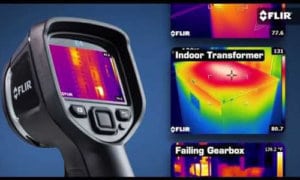Thermal imaging cameras have only developed in sophistication, with impressive and clear images and sharp results. The breath of the modern spectrum is vast – from near infrared at 0.7 to 1.3 microns, to mid-infrared at 1.3 to 3 microns and thermal infrared at 3 microns to over 30 microns.
The Irish coastguard has proudly used infrared since the 1980s and modern Forward-Looking Infrared or FLIR are an invaluable tool.
The first benefit of thermal imaging for the coast guard is simple – efficient search and rescue operations.
The images of heat and colour provide a whole new perspective of the water. Instead of looking for a small figure in dark clothing in dark waters, there is a warm body glowing brightly among cold waves.
A heat signature is a sign of life and hope and a beacon that sends the coastguard helicopters in the right direction. This can all save a lot of time in an emergency.

Instead of scouring a coastline with no idea where to look, a quick sweep with thermal imaging should be enough. It gives a clear yes or no answer to questions about life in the water.
The other potential benefit of using thermal images in this instance is that we remove the physical barriers of normal sight.
This is best seen in emergencies with capsized boats and wrecks. This is no longer about looking for a body in water; this is about a body that may be entirely hidden from view in the wreckage. Again, it speeds up the process and lets coastguard hone in on an area.
Speed is essential here because cold waters can kill and there is only so much fuel in a helicopter and so many hours of light in a day.
Thermal imaging extends the scope and lets pilots travel further in their flight time and could save lives. The addition of 360-degree cameras on modern systems also reduces the time by providing a wider field of view. This also eliminates the risk of blind spots on a fly past.
 Thermal imaging does more for Irish coastguard pilots than act as a search tool.
Thermal imaging does more for Irish coastguard pilots than act as a search tool.
The main focus here is on search and rescue because of this clear benefit for life-saving and rescues. Other functions can come with a good thermal system on the aircraft and air base.
Thermal imaging is a valuable tool in maintenance and repair, especially with engines. These cameras can pick up heat signatures of defective parts in machines that may not be visible to the naked eye.
These faults are then picked up sooner, saving time and money in the long run. Also, there is the chance this could also save lives if an unnoticed fault were to damage a helicopter mid-flight.
In the end, there is no doubt that infrared cameras are a must for the Irish Coastguard, and any other search and rescue agency. Without them, the job would be a lot tougher. Pilots now have even greater peace of mind that the aircraft is safe and missions can be successful.
